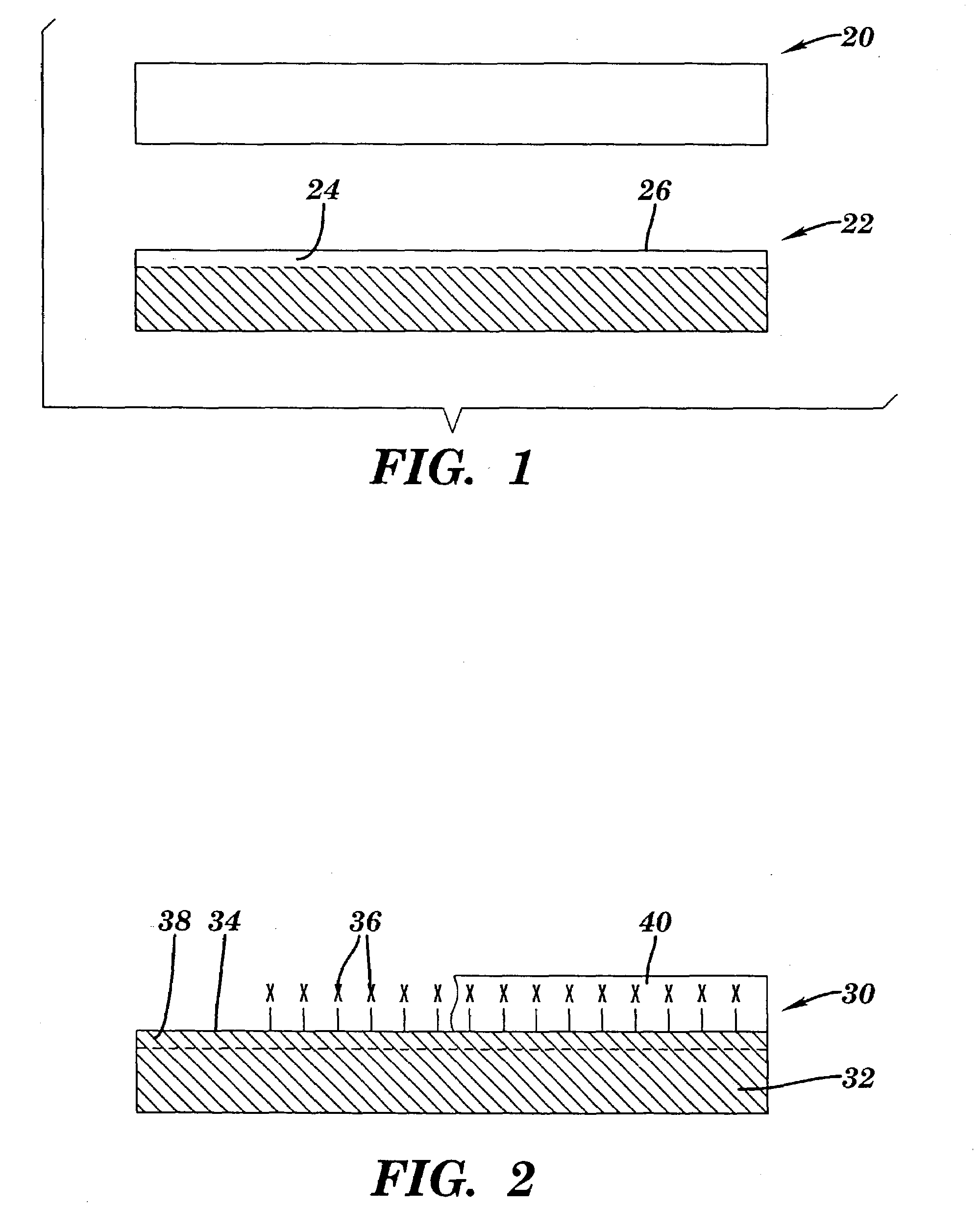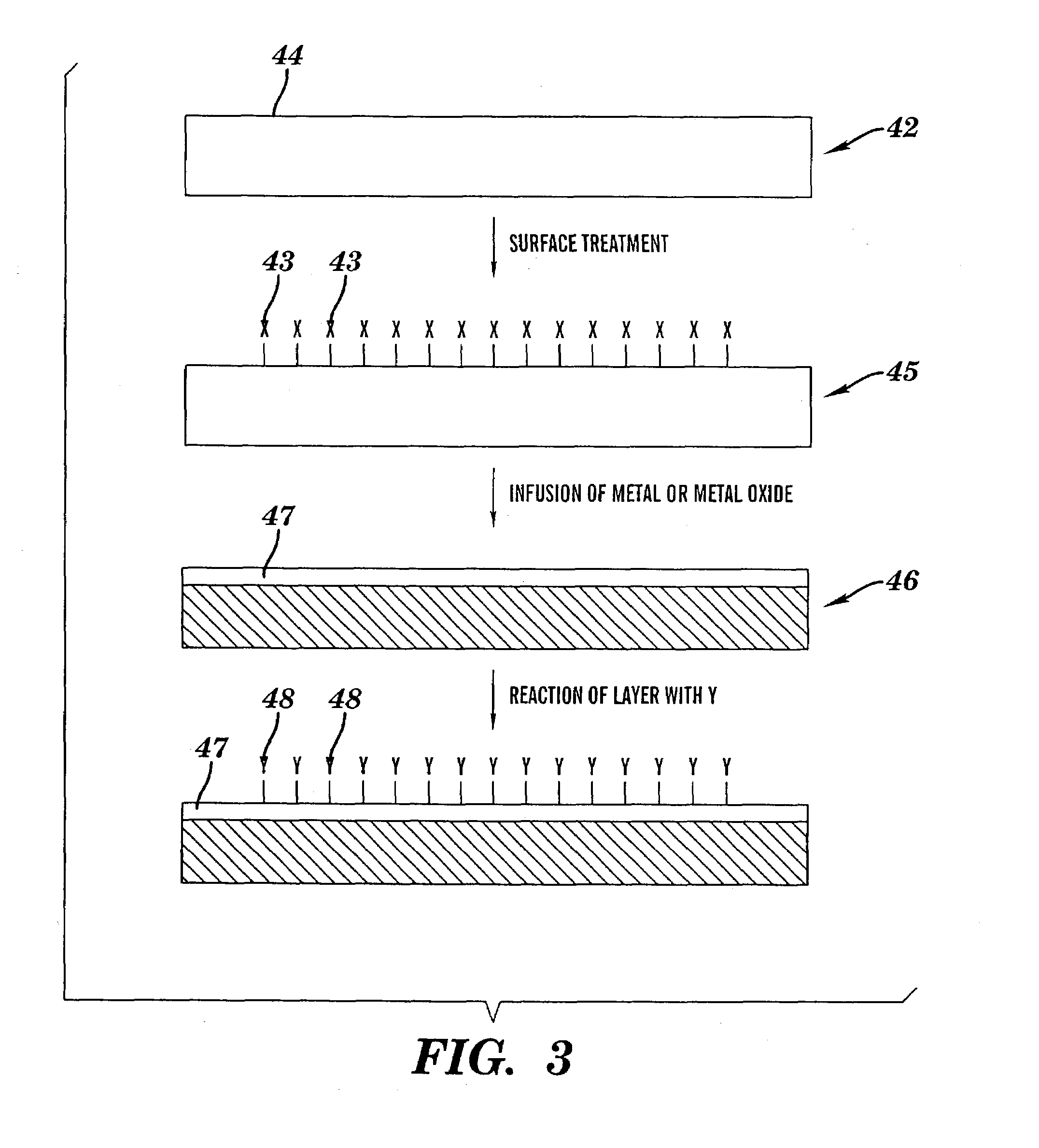Polymer composites and methods for making and using same
- Summary
- Abstract
- Description
- Claims
- Application Information
AI Technical Summary
Benefits of technology
Problems solved by technology
Method used
Image
Examples
example 1
Preparation and Characterization of V2O5 in Polytetrafluoroethylene-co-hexafluoropropylene
[0230]A 12″×2″ piece of polytetrafluoroethylene-co-hexafluoropropylene, (“FEP”) (Dupont), was wrapped around itself to form a loose fitting coil and then placed in a 100 ml round bottom flask. The flask was connected to a vacuum line and then pumped down to less than 10 mTorr pressure. Next, ca. 1 ml of V(O)Cl3 (Strem) was vacuum transferred to the 100 ml round bottom flask. The flask was then closed and heated to ca. 75° C. under vacuum so that a gas phase of V(O)Cl3 filled the entire volume of the flask for 1 hr. The flask was removed from the heat, and its temperature lowered to about room temperature. The V(O)Cl3 was then vacuum transferred off the FEP polymer, and the 100 ml round bottom flask was opened to ambient air.
[0231]Upon opening the flask, the FEP polymer was transparent to the eye but, within a few minutes, began to turn yellow-orange and reached its darkest level after a few hou...
example 2
Preparation and Characterization of V2O5 in Polyethyleneterephthalate
[0233]The same experiment as described in Example 1 was performed using a piece of polyethyleneterephthalate (“PET”), which is a polyester containing only aliphatic carbon and ester functionality. Upon exposing the PET in the same manner as that described in Example 1, the same observations were made. That is, initially the PET film was transparent and within a few hours turned to yellow green. Although the color to the eye was slightly different, the UV-vis results showed a similar spectrum as that observed for the FEP. XPS, on the other hand, showed a binding energy of ca. 517.5 eV which is consistent with V2O5. This further supports the results in Example 1, which indicated that the vanadium was somehow complexed to the fluorine functionality thereby increasing its XPS binding energy. These results suggest that the electronic state of the inorganic material in the free volume of the polymer matrix can be influen...
example 3
Preparation and Characterization of Fe2O3 in Polytetrafluoroethylene-co-hexafluoropropylene
[0234]A piece of FEP polymer was treated exactly in the same manner as that described in Example 1, except that instead of using V(O)Cl3, 1 ml of Fe(CO)5 was vacuum transferred to the flask containing the FEP. The temperature and treatment time was identical to those described in Example 1. Upon removal the film turned deep orange. XPS and UV-vis results indicated the formation of Fe2O3. A slight shift to higher binding energy in the XPS for the Fe2O3-FEP material indicated that the iron was, in some manner, electronically coupled to the fluorine functionality in the FEP.
[0235]In accordance with this invention the materials are contemplated as useful light and electromagnetic radiation shields or filters. Examples 1–3 showed that vanadium and iron macromolecular networks can be formed within FEP and PET. Both of FEP and PET are lightweight and flexible. Additionally, the FEP material is extrem...
PUM
| Property | Measurement | Unit |
|---|---|---|
| Volume | aaaaa | aaaaa |
| Volume | aaaaa | aaaaa |
| Volume | aaaaa | aaaaa |
Abstract
Description
Claims
Application Information
 Login to View More
Login to View More - R&D
- Intellectual Property
- Life Sciences
- Materials
- Tech Scout
- Unparalleled Data Quality
- Higher Quality Content
- 60% Fewer Hallucinations
Browse by: Latest US Patents, China's latest patents, Technical Efficacy Thesaurus, Application Domain, Technology Topic, Popular Technical Reports.
© 2025 PatSnap. All rights reserved.Legal|Privacy policy|Modern Slavery Act Transparency Statement|Sitemap|About US| Contact US: help@patsnap.com



